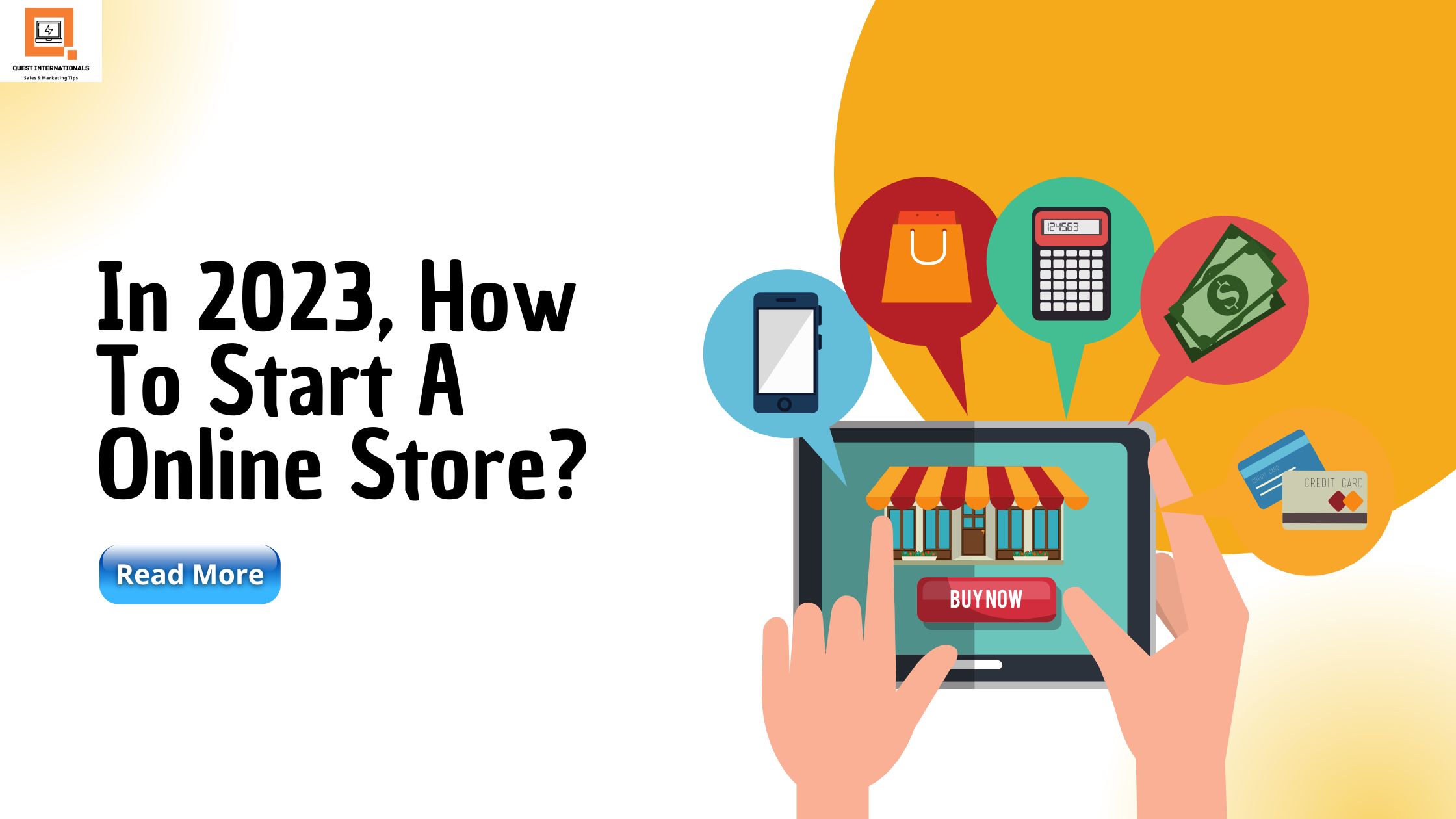Table of Contents
ToggleOnline shopping has experienced remarkable growth in recent years, as an increasing number of individuals have started to utilize the internet to buy products and services. The COVID-19 pandemic has further boosted this trend, with numerous physical stores shutting down and shifting their attention towards online sales. Consequently, more people are interested in learning how to start an online store. In 2023, creating an online store has become an appealing choice for entrepreneurs seeking to establish a new business or grow an existing one.
One of the biggest benefits of starting an online store is the low startup costs compared to a traditional brick-and-mortar store. You don’t need to worry about rent, utilities, or other overhead expenses, and you can often run your online store from the comfort of your own home. Additionally, an online store allows you to reach a global audience and operate 24/7, giving you the potential to make sales around the clock. To start an online store, there are several key steps you need to follow, including choosing a niche, conducting market research, creating a business plan, selecting an e-commerce platform, designing and developing your website, setting up payment and shipping options, and launching and marketing your store. In the following sections, we’ll explore each of these steps in more detail.
how to start a online store in 2023: 7 Essential Steps
Starting an online store can be a great way to grow your business in 2023. With the growing popularity of online shopping, having a digital storefront can help you reach a wider audience and increase your sales. Here are 7 essential steps to help you get started:
Step 1: How to Start an Online Store by Choosing a Niche
When starting an online store, choosing a profitable niche is crucial to your success. A niche is a specific area of focus within a broader industry or market, such as organic skincare, sustainable fashion, or gourmet coffee. By choosing a niche, you can differentiate yourself from the competition and become an expert in a specific area, which can help you attract and retain customers.
How To choose a perfect niche
To select a profitable niche, you need to do your research. Start by identifying your interests, passions, and expertise. This will help you choose a niche that you are passionate about and can speak to with authority. Next, use online tools like Google Trends, Amazon Bestsellers, and social media to identify trends and consumer demand within your niche.
You can also conduct keyword research using tools like Google Keyword Planner and SEMrush to identify popular search terms and phrases related to your niche.
Once you’ve identified a potential niche, do some competitive analysis to see what other businesses are already operating in that space. Look for gaps in the market and areas where you can differentiate yourself from the competition.
Finally, consider the profitability of your chosen niche. Look at factors like the average order value, customer lifetime value, and profit margins to ensure that your business will be financially viable over the long term. By carefully selecting a profitable niche, you can set yourself up for success and increase your chances of building a thriving online store. Every business owner should know to how to create business plan. If a business owner knows how to create business plan then sharting an online store get’s easier for them.
If you are like most the business owners who want to know the latest trends in the market then you should definitely read our Magzine ’Marketing Enigma’. Our magazine is dedicated to providing valuable insights and information on all things marketing. From social media strategies to email marketing tips, we’ve got you covered. We pride ourselves on staying up-to-date with the latest industry news and sharing our knowledge with our readers.

Step 2: Conduct Market Research
Once you have identified a potential niche for your online store, the next step is to conduct market research to gain a better understanding of your competition and target audience. Market research will help you make informed decisions about your business strategy, product offerings, pricing, and marketing tactics.
One key aspect of market research is understanding your competition. Identify who your main competitors are, what they offer, and how they position themselves in the market. Look for opportunities to differentiate your business from theirs, whether it’s by offering unique products, providing better customer service, or leveraging a different marketing strategy.
Another important aspect of market research is analyzing your target audience. Who are your ideal customers? What are their demographics, interests, and pain points? Understanding your target audience will help you create a more effective marketing strategy and develop products that meet their needs.
To conduct market research, you can use a variety of methods, including surveys, focus groups, and social media listening. You can also use online tools like Google Analytics, Facebook Insights, and market research reports to gather data and insights about your target audience. By conducting thorough market research, you can gain a deeper understanding of your industry, competition, and target audience, which will help you make more informed decisions about your business and increase your chances of success.
Step 3: Create a Business Plan
Creating a business plan is an essential step in starting an online store or if you want to learn how to start a online store. A business plan is a comprehensive document that outlines your business goals, strategies, and financial projections. It serves as a roadmap for your business, helping you to stay focused, make informed decisions, and secure financing if needed.
One of the main benefits of having a business plan is that it forces you to think critically about your business and identify potential challenges and opportunities. By conducting market research and outlining your business strategies, you can identify potential risks and develop contingency plans to mitigate them. A business plan also helps you to stay accountable and measure your progress towards your goals over time.
Key components of a business plan include:
- Executive summary: A brief overview of your business, including your mission statement, business goals, and key strategies.
- Market analysis: An overview of your industry and target market, including market size, trends, and competition.
- Products and services: A detailed description of your products or services, including pricing, distribution, and unique selling propositions.
- Marketing and sales: Your marketing and sales strategies, including target audience, channels, and promotions.
- Operations and management: An overview of your business operations, including staffing, logistics, and suppliers.
- Financial projections: Financial projections, including startup costs, revenue, and expenses, and cash flow projections.
By creating a comprehensive business plan, you can set yourself up for success and increase your chances of building a profitable online store.
Step 4: Choose a platform for your online store
Choosing the right e-commerce platform is crucial for learning how to start a successful online store. There are many e-commerce platforms available, and each has its own advantages and disadvantages, but which is the best place to start an online store? Some popular e-commerce platforms include Shopify, WooCommerce, Magento, and BigCommerce.
When comparing e-commerce platforms, it’s important to consider factors such as:
- Ease of use: Is the platform user-friendly and easy to navigate? Do you need any technical knowledge to set up and manage your store?
- Features and customization: Does the platform offer the features and customization options that you need? Can you customize the design and layout of your store to reflect your brand?
- Payment and shipping options: Does the platform support the payment and shipping options that you need? Can you integrate with third-party payment processors and shipping carriers?
- Security and reliability: Is the platform secure and reliable? Does it offer SSL encryption and other security features to protect your customers’ data?
- Cost: What are the costs associated with using the platform? Are there any transaction fees or additional costs for add-ons and extensions?
It’s also important to consider the scalability of the platform. Will it be able to handle increased traffic and sales as your business grows? Can it integrate with other business tools and software that you may need in the future?
Ultimately, the platform you choose will depend on your specific needs and preferences. You have to decide on your own which is the best place to start an online store. Consider your budget, technical expertise, and business goals when selecting an e-commerce platform for your online store, and then you easily learn how to start a online store.
Step 5: Design and Develop Your Online Store
When designing your e-commerce website, it’s also important to consider the overall look and feel of your site. Choose a color scheme and design that reflects your brand and appeals to your target audience. Make sure your website is optimized for mobile devices, as many customers will be shopping on their smartphones.
Here are some tips for designing an attractive and user-friendly e-commerce website:
- Keep it simple: Avoid clutter and keep your website design simple and easy to navigate.
- Use high-quality images: Use high-quality images that showcase your products in the best possible light.
- Use white space: Use plenty of white space to help your products stand out and make your website feel more spacious.
- Use clear calls to action: Use clear and compelling calls to action to encourage visitors to browse and make purchases.
- Test and optimize: Continually test and optimize your website to improve its performance and user experience.
By designing an attractive and user-friendly e-commerce website, you can create a positive user experience and increase your chances of converting visitors into customers.
Step 6: Set up Payment and Shipping Options
Setting up payment and shipping options is a critical step in starting your online store. You’ll need to choose payment processing and shipping options that are secure, reliable, and convenient for your customers.
Payment Processing Options:
There are several payment processing options available for e-commerce businesses, including
- Credit cards
- PayPal
- Apple Pay and Google Wallet
Shipping Options:
When it comes to shipping, there are several options available, depending on your business needs and the preferences of your customers. Some shipping options include
- USPS, FedEx, and UPS
- Flat-rate shipping
- Free shipping
It’s important to choose payment and shipping options that are affordable, reliable, and convenient for your customers. You may also want to consider offering tracking information and delivery notifications to keep customers informed about the status of their orders.
By setting up secure and convenient payment and shipping options, you can provide a positive shopping experience for your customers and increase the likelihood of repeat business.
Step 7: Launch and Market Your Online Store
Once you have completed the previous steps, you are ready to launch and market your online store. Launching your e-commerce store involves making it live on the internet and making sure it is functional and user-friendly. Here are some tips for launching your e-commerce store:
- Test your website thoroughly: Before launching your e-commerce store, make sure to test your website thoroughly to ensure it is functional and user-friendly.
- Set up tracking and analytics: Set up tracking and analytics tools to track your website’s performance and identify areas for improvement.
- Create social media accounts: Create social media accounts for your online store and start building a following.
- Create content: Create content for your website, such as blog posts or product descriptions, to improve search engine visibility and engage with your audience.
- Offer promotions: Consider offering promotions or discounts to entice customers to make their first purchase.
Once your e-commerce store is live, you’ll need to start marketing it to attract customers and drive sales. Here are some strategies for marketing your online store:
- Search engine optimization (SEO): Optimize your website for search engines to improve visibility and attract organic traffic.
- Pay-per-click (PPC) advertising: Use platforms like Google Ads to run targeted advertising campaigns.
- Social media marketing: Use social media to promote your products and engage with customers.
- Email marketing: Use email marketing to stay in touch with customers and promote your products.
- Influencer marketing: Collaborate with influencers or bloggers in your niche to reach a wider audience.
By launching and also marketing your online store effectively, you can increase brand awareness, attract customers, and drive sales. It’s important to continually test and refine your marketing strategies to achieve the best possible results.
Conclusion
We hope now you have understood now how to start a online in 2023 can be a profitable venture with the right approach. To recap the key points of starting an online store, it’s important to
- Choose a profitable niche.
- Conduct market research to understand your competition and target audience.
- Create a business plan.
- Choose a platform for your online store.
- Design and develop your website.
- Set up payment and shipping options.
- Launch and market your online store.
By following these steps, you can learn how to start a online store that attracts customers and drives sales. However, it’s important to keep in mind that starting an online store requires dedication, hard work, and a willingness to learn and adapt to changing market trends.
As technology and consumer behavior continue to evolve, it’s essential to stay up-to-date with the latest e-commerce trends and best practices. By continually improving your online store and as well as adapting to the changing needs of your customers, you can achieve long-term success and growth in the competitive world of e-commerce. We hope you enjoyed reading this blog and don’t forget to subscribe our ‘Marketing Enigma’ Magazine. Click on the button Below now.





